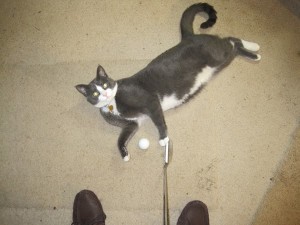This is a factoid (does anybody use that word anymore?) I have mentioned before, but I want to develop the point today. There is a break-even distance in putting. That is the distance from which a golfer averages 2.0 putts.
From farther away, the player would average more than two putts (three-putt more often that one-putt). From closer in, the average would be less than two putts.
The break-even distance for the average recreational golfer is 15 feet. For touring professionals, the distance is just over twice that, about 32 feet.
What I get from this comparison is to try to push that break-even distance out as far as I can. I will never have a professional golf swing, but there’s no reason I can’t be nearly as good with a putter.
One of the putting drills I do occasionally is to hit ten fifteen-foot putts, without three-putting. Then I do the same from twenty feet, twenty-five feet, and thirty feet. Sometimes I do take three putts, but sometimes, one goes in!
If you try this drill, don’t putt from the same spot over and over. You can’t groove your stroke when you play, so you shouldn’t do it when you practice, at least not in this drill.
Oh, yes. You have to putt out. No fair giving yourself the leave. Sometimes you really blow it and leave your first putt four feet short. If you do it here, you’ll do it on the course, too, so you might as well get comfortable cleaning up your messes.
When you’re finished and have hit your forty putts, test yourself. Put one ball on the green at each distance and putt them out in this order:
Twenty feet,
Thirty-five feet,
Fifteen feet,
Twenty-five feet.
As you do this drill, and start to get good at it, you’ll find yourself thinking deeply about how you putt from distance, looking for how to make long putts accurate and repeatable. That will only make you a better putter.
What I get out of this drill is when I have a long putt, I feel confident I can leave it close to the hole, and sometimes luck will take over.
That takes a lot of stress out of being on the green. Not to mention, it lowers your score.





